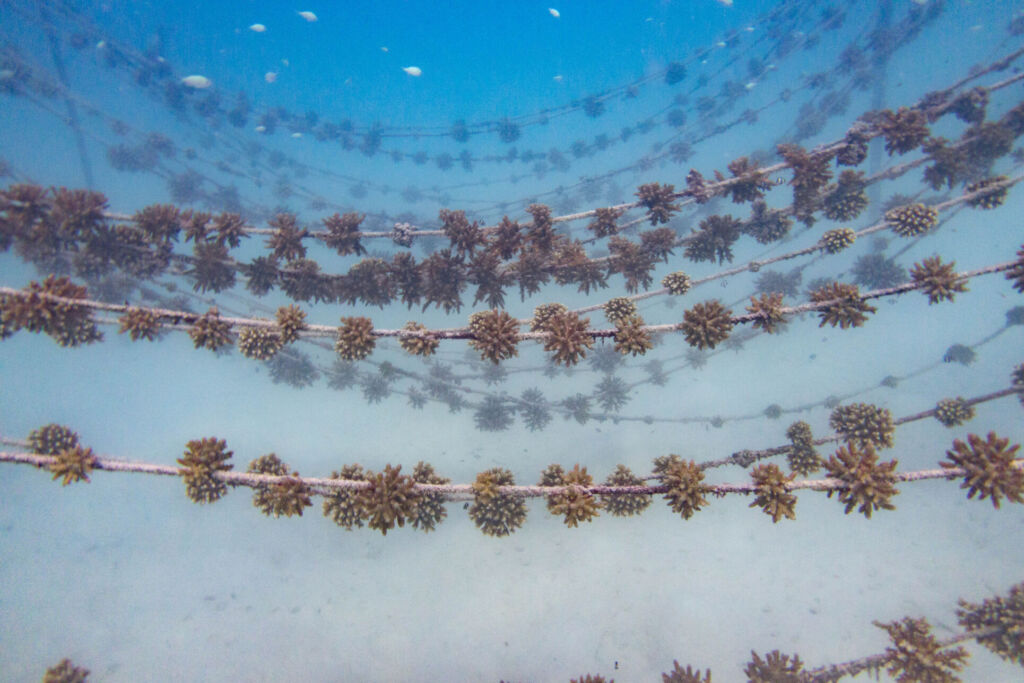OVERVIEW
The Coral Line Project at Gili Lankanfushi started in 2014, and has been growing ever since. The simple goal of this project is to grow coral fragments in a rope nursery and transplanted them back to the natural reef after they become mature colonies. During the first year after a coral line is made, it is monitored by our marine biologists every quarter to measure its size for growth and document the living condition of the corals to calculate survival rates. During the year 2020, our resort was closed from operations for 6 months, but were still able to make some good progress with deploying and transplanting new and old coral lines. Throughout the operational months, we made 25 new lines with our guests. As of December 31st 2020, the lines made to date totaled to 279.

Section of the Coral Lines Project nursery.
NURSERY COMPOSITION
The snapshot at the end of the year, shows our nursery is currently composed of 193 lines of 20 identified species and a few unidentified ones. Our nursery is made up of 7 genera of corals dominantly made up of 79.3 % Acropora species. Among the Acropora species, the most abundant Acropra humulis makes up a quarter of the lines and the other three quarters are a mix of 13 other Acropora species.


MONITORING STATISTICS
We studied the species as the differentiating factor of survival and growth. In the span of 12 months, Acropora hyacinthus had the highest survival % of 88.8% and Acropora muricata had the most growth of 147mm. Interestingly, Acropora muricata may be fast growing but has the lowest survival % of 55.4%. Montipora digitate had the lowest growth of actually – 1.1mm over 12 months. This may indicate that it is not a very suitable candidate for rope nursery method.

The monitoring data is also divided quarterly to observe for any seasonal changes. During the first quarter of 2020, a total of 13 new lines were installed in the Coral Project Nursery. During this period of 3 months, 20 other monitored lines had mean growth of 5.5mm and a mean survival rate of 89.9%. If the 13 new lines were included in the survival rate (all new lines have 100% survival rate), the mean survival rate was 93.9%.
Due to unexpected resort closure, monitoring of coral lines was limited during the second quarter of 2020. No new lines were made and of the 29 lines that were supposed to be monitored, only 4 were. Of the 4 lines which were monitored in April, the mean growth was 4.5mm and mean survival rate of 91.8%.
During the third quarter, 3 new lines were introduced to the nursery and 27 lines were monitored. The monitored lines had a mean growth rate of 2.3mm and mean survival rate of 66.2%, or 69.6% if the new lines were included.
For the last quarter, 9 new lines were made and 34 lines were monitored. The mean growth rate of the monitored lines was 4.4mm and survival of 58.0%, or 67.5% when also considering the newly made lines.
It was interesting to see a lower survival rate towards second half of the year. This perhaps could be due to the minor heating event which occurred during May and then could have affected the survival statistics when the lines were due for their monitoring later in the year.
TRANSPLANTING
Of the coral lines already in the nursery, we transplanted 11 lines to the reef by scuba diving. They are currently being monitoring and so far seem to be doing well! Majority of them have attached to natural substrate, growing beautifully and attracting a lot of local marine life. Transplanted lines are all from the Acropora genus of the following species:
A. humilis
A. hyacinthus
A. latistella
A. millepora
A. nasuta
A. platagenia
A. secale
A. tenuis
A. valida
A. vermiculata

Transplanted corals and snappers swimming around the corals.
MORTALITY
23 of our lines died this year. It is suspected that these lines were not able to withstand the stress of a minor heating event which occurred around May. However, the data is still invaluable to the overall research and was taken into account during data analysis. The few living colonies from some of the lines have been fragmented and used for the new lines.
SUMMARY
Despite the challenges faced this year, we were still successful in deploying new lines and transplanting coral back to our reef. The transplants being monitored right now are showing good results and we are excited to share the outcome in the future. 2021 looks like it will be a big year for transplanting as many of the lines hanging in the nursery are ready to move to their forever home on the reef! Look out for future updates.